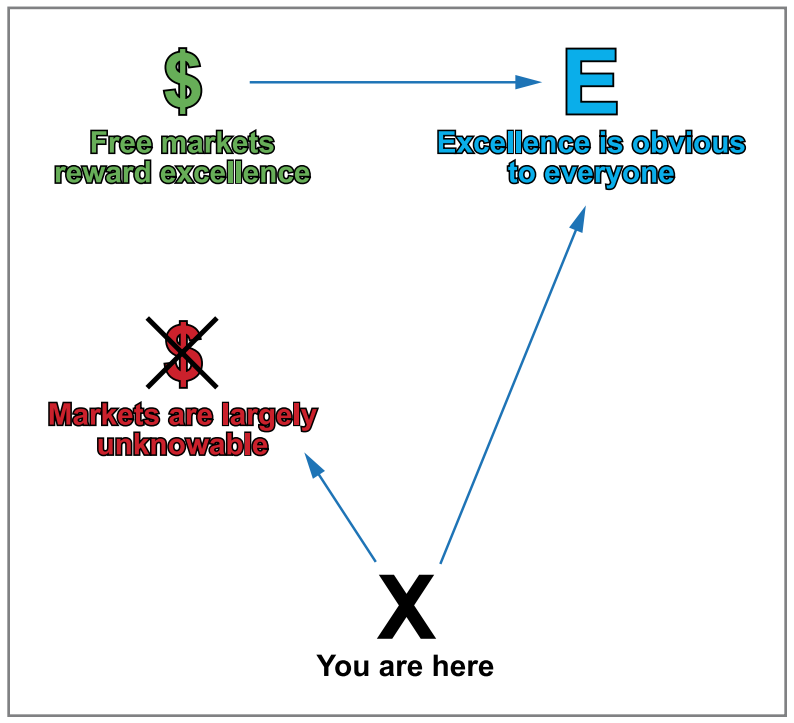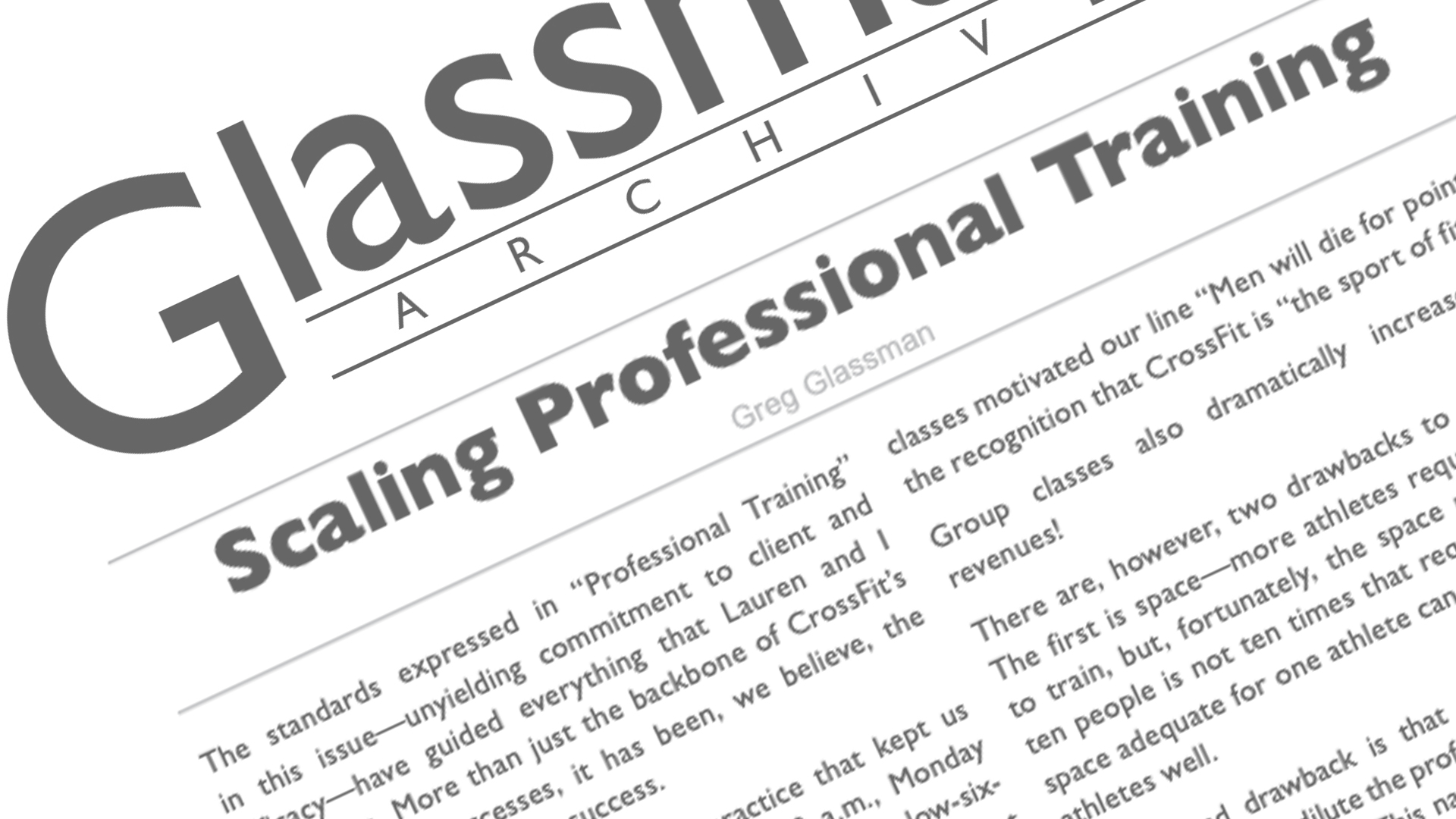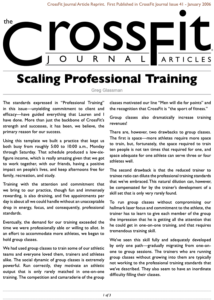By Greg Glassman
This article, by BSI’s co-founder, was originally published in The CrossFit Journal. While Greg Glassman no longer owns CrossFit Inc., his writings and ideas revolutionized the world of fitness, and are reproduced here.
Coach Glassman named his training methodology ‘CrossFit,’ which became a trademarked term owned by CrossFit Inc. In order to preserve his writings in their original form, references to ‘CrossFit’ remain in this article.
Download a pdf of the original article HERE.
The standards expressed in “Professional Training” in this issue—unyielding commitment to client and efficacy—have guided everything that Lauren and I have done. More than just the backbone of CrossFit’s strength and successes, it has been, we believe, the primary reason for our success.
Using this template we built a practice that kept us both busy from roughly 5:00 to 10:00 a.m., Monday through Saturday. That schedule produced a low-six figure income, which is really amazing given that we got to work together, with our friends, having a positive impact on people’s lives, and keep afternoons free for family, recreation, and study.
Training with the attention and commitment that we bring to our practice, though fun and immensely rewarding, is also draining, and five appointments per day is about all we could handle without an unacceptable drop in energy, focus, and consequently, professional standards.
Eventually, the demand for our training exceeded the time we were professionally able or willing to allot. In an effort to accommodate more athletes, we began to hold group classes.
We had used group classes to train some of our athletic teams and everyone loved them, trainers and athletes alike. The social dynamic of group classes is extremely powerful. Run correctly, they motivate an athletic output that is only rarely matched in one-on-one training. The competition and camaraderie of the group classes motivated our line “Men will die for points” and the recognition that CrossFit is “the sport of fitness.”
Group classes also dramatically increase training revenues!
There are, however, two drawbacks to group classes. The first is space—more athletes require more space to train, but, fortunately, the space required to train ten people is not ten times that required for one, and space adequate for one athlete can serve three or four athletes well.
The second drawback is that the reduced trainer to trainee ratio can dilute the professional training standards that we’ve embraced. This natural dilution can, however, be compensated for by the trainer’s development of a skill set that is only very rarely found.
To run group classes without compromising our hallmark laser focus and commitment to the athlete, the trainer has to learn to give each member of the group the impression that he is getting all the attention that he could get in one-on-one training, and that requires tremendous training skill.
We’ve seen this skill fully and adequately developed by only one path—gradually migrating from one-on-one to group sessions. The trainers who are running group classes without growing into them are typically not working to the professional training standards that we’ve described. They also seem to have an inordinate difficulty filling their classes.
This is exactly how Lauren and I built our group classes. After working for years at the limit of our one-on-one capacity, we started accepting new clients by doubling them up with other one-on-one clients to form one-on-two appointments.
We introduced the shift to group classes by telling the existing one-on-one clients that we had good news for them: “Your training rate is going to go down and we’re going to introduce you to a new friend.” Where there was resistance to sharing the time we asked for a trial period. It went swimmingly well.
We structured payment so that a client who was paying, say, $75 per session would now be paying only $50. This drives the trainer’s hourly revenue up and reduces the clients’ costs per session. This prompted many to come more often. When our schedules filled and it became necessary to bring a third person to each group we brought the individual rate to $40 per session and again the trainer’s hourly rose and the client’s costs fell. With the addition of each new athlete to the session, the rates fall for the athlete and rise for the trainer, and it all works perfectly unless there’s a perceived reduction in attention.
All the demands on the trainer skyrocket in this situation however. Attention, enthusiasm, voice projection, and engagement all have to escalate. It is an acquired skill—an art, really. Our goal is too give so much attention and “in your face” presence to each participant that each is actually grateful that he didn’t get more attention. The essential shift is that the level of scrutiny and criticism is ratcheted up along with the rate of praise and input for each client. The trainer becomes extremely busy. There’s no way a new trainer can walk into this environment and do well. (Imagine the decline in standards for those trainers who are participating in their classes while trying to lead them. We see this too often, and the training is always substandard.)
Within two years Lauren and I had morphed our one-on-one practice to all group classes without increasing the number of hours we worked each week, although we both kept a couple of choice one-on-one clients. We charged $15 per class and averaged ten to fifteen athletes per session.
This substantially raised our income. It also gave a much-noticed boost to the stability of our practice. Seasonal fluctuations due to summer and Christmas vacations largely disappeared. With a one-on-one practice, when three clients you see two or three times per week are, by coincidence, on vacation simultaneously, income takes a hit. Not so with group classes.
At the same time we started converting our practice from one-on-one to group classes we launched CrossFit.com. The launch of the website was motivated by the same commitment to client and efficacy that motivated our training. We were looking not to increase our revenues but to favorably impact more people with our training. The difference may seem inconsequential, but the public clearly knows the difference.

The group classes, the website, this journal, our seminars, and our affiliate program were all introduced to bring more quality training to more people. Each of these additions also increased CrossFit’s value for everyone involved. It was our original one-on-one clients who initially came to and benefited from the group classes, subscribed to the journal, visited the website, and attended the seminars. Every CrossFit expansion has served the entire community.
Lauren and I, and CrossFit, are in pursuit not of money but of excellence. The difference, we believe, is the difference between success and failure. The pursuit of excellence is the heart of our business plan. Money is, for many, elusive because markets are unknowable. But while markets are unknowable, excellence is obvious to most everyone, especially free, and large, markets.
If you can accept the three premises that: markets are largely unknowable, excellence is obvious to everyone, and free markets reward excellence it becomes obvious that the most effective business plan comes from achieving excellence and letting the market bring the money to you. The efficiency and effectiveness of this paradigm is breathtaking.
We’ve used the pursuit of excellence to guide our every move. For instance, when we were considering the last expansion of CrossFit Santa Cruz we couldn’t determine whether it would be financially feasible or not. The variables were too numerous and the assumptions too uncertain to convince any accountant of the wisdom of expansion, but when we asked the simple question, “Will it improve the quality of the programming and the training experience?” the answer was a resounding “Yes!” On expansion, the CrossFit Santa Cruz numbers tripled within six months and the extra space allowed for some refinements and additions to our programming that wouldn’t have been possible otherwise.
As our seminars, journal, website, and affiliate program grew, we handed off the group classes to a new generation of CrossFit trainers who now cover most of the overhead costs of CrossFit Santa Cruz. This has afforded Lauren and me time and opportunity to commit more energy and resources to new projects that support and develop the CrossFit community.
- Download Original PDF
- Download Español (Spanish) PDF
- Download Português (Portuguese) PDF
- Download Italiano (Italian) PDF
- Download Français (French) PDF
Greg Glassman founded CrossFit, a fitness revolution. Under Glassman’s leadership there were around 4 million CrossFitters, 300,000 CrossFit coaches and 15,000 physical locations, known as affiliates, where his prescribed methodology: constantly varied functional movements executed at high intensity, were practiced daily. CrossFit became known as the solution to the world’s greatest problem, chronic illness.
In 2002, he became the first person in exercise physiology to apply a scientific definition to the word fitness. As the son of an aerospace engineer, Glassman learned the principles of science at a young age. Through observations, experimentation, testing, and retesting, Glassman created a program that brought unprecedented results to his clients. He shared his methodology with the world through The CrossFit Journal and in-person seminars. Harvard Business School proclaimed that CrossFit was the world’s fastest growing business.
The business, which challenged conventional business models and financially upset the health and wellness industry, brought plenty of negative attention to Glassman and CrossFit. The company’s low carbohydrate nutrition prescription threatened the sugar industry and led to a series of lawsuits after a peer-reviewed journal falsified data claiming Glassman’s methodology caused injuries. A federal judge called it the biggest case of scientific misconduct and fraud she’d seen in all her years on the bench. After this experience Glassman developed a deep interest in the corruption of modern science for private interests. He launched CrossFit Health which mobilized 20,000 doctors who knew from their experiences with CrossFit that Glassman’s methodology prevented and cured chronic diseases. Glassman networked the doctors, exposed them to researchers in a variety of fields and encouraged them to work together and further support efforts to expose the problems in medicine and work together on preventative measures.
In 2020, Greg sold CrossFit and focused his attention on the broader issues in modern science. He’d learned from his experience in fitness that areas of study without definitions, without ways of measuring and replicating results are ripe for corruption and manipulation.
The Broken Science Initiative, aims to expose and equip anyone interested with the tools to protect themself from the ills of modern medicine and broken science at-large.
Support the Broken Science Initiative.
Subscribe today →
recent posts
Can we preserve muscle while eating less often?
Medical Society Webinar with David Wiss




